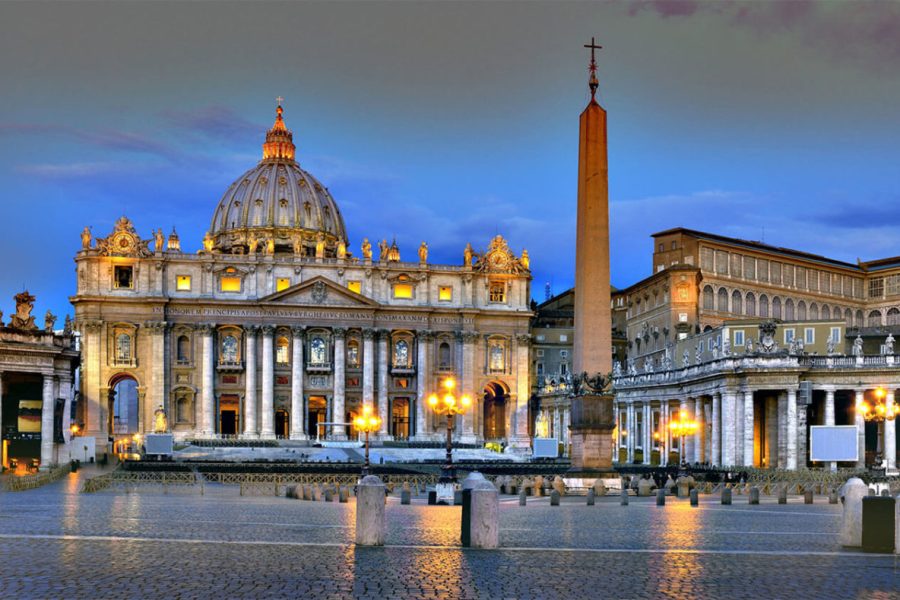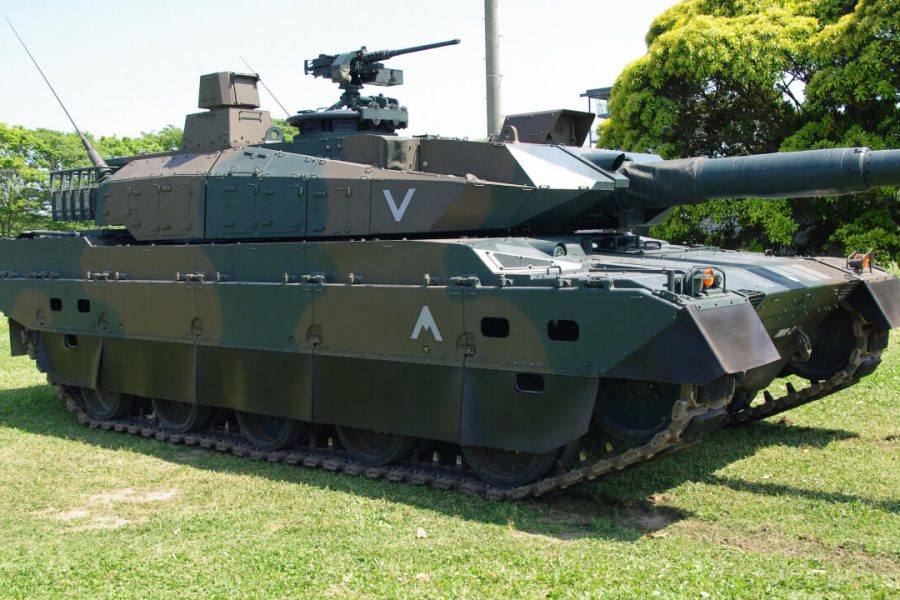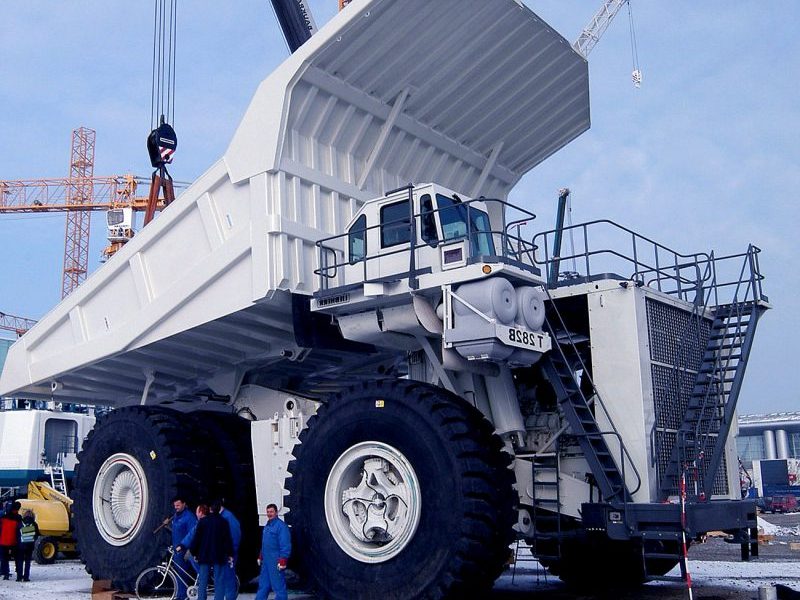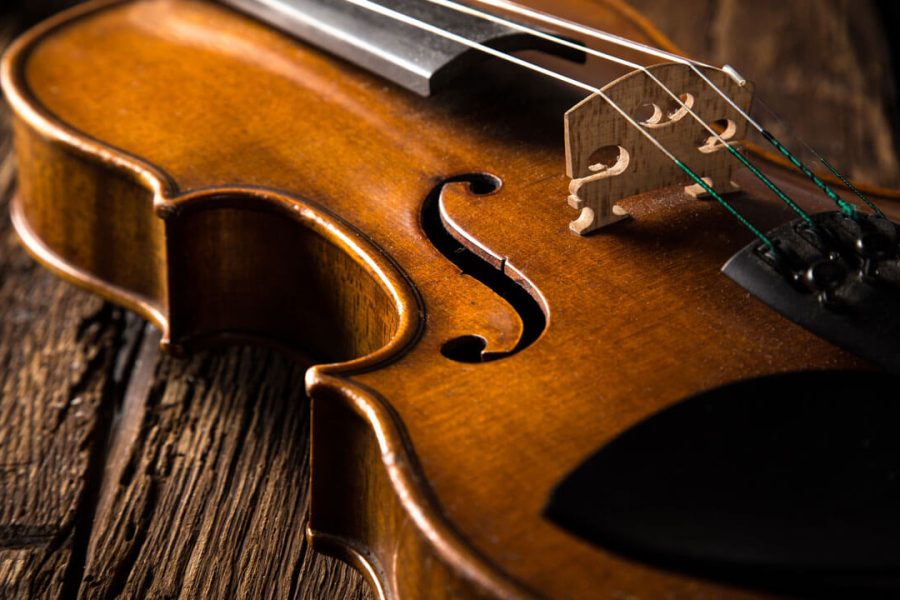In the modern world, the value of coins depends not only on the denomination displayed on them, but sometimes it becomes many times higher due to subtleties of execution. And so now we will try to find out what is the most expensive coin in the world and what is its value?
The most expensive coins in the world
Constantine ruble - 500 thousand dollars

The silver ruble, which was issued in 1825, is the rarest representative of ancient coins that were used in the territory of the Russian Empire together with kopecks, and is included in the top 10 most expensive coins in the world. And also properly represents one of the most expensive coins in the world. It is absolutely known about five with a rim on which an inscription is applied, and three more with a smooth rim.
This coin was made of 900-grade silver, weighing 20.73 g. The front side is decorated with the profile of Konstantin Pavlovich. On the back side is an eagle surrounded by a laurel wreath. The ruble was developed and minted in Russia directly in St. Petersburg. Throughout the history of this specimen, many attempts have been made to counterfeit it. In 2010, this unique coin was bought for $500,000.
Gold dinar - 1 million dollars

The oldest gold dinar found in the Middle East and one of the most valuable coins in the world. Historians call it the Hashimi Dinar and believe it was minted in honor of the pilgrimage of Caliph Umar Ibn Abd Al-Aziz (which is actually the name of a town in Saudi Arabia). The auction price was $1 million. The dinar is considered one of the most important coins minted on the Arabian Peninsula.
Brasher Gold Doubloon - $2.9 million
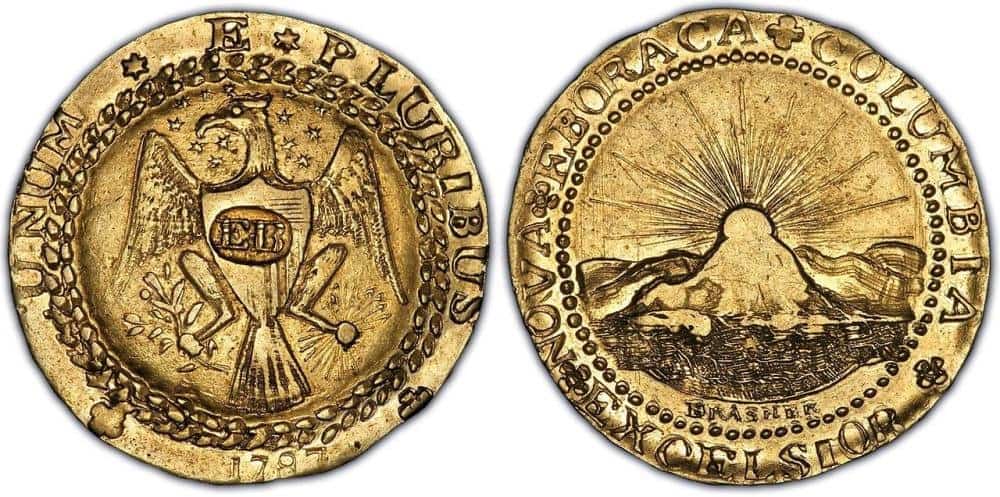
The next example of expensive coins is represented by the works of the famous jeweler Ephraim Brasher. The master minted coins from gold, as well as silver, and decided to do copper decoration. The master values works of art such as coins called the Golden Doubloon, where the initials of the jeweler "E.V." are displayed. The cost of such coins can vary around 2,900,000 dollars.
Liberty Head - $3 million
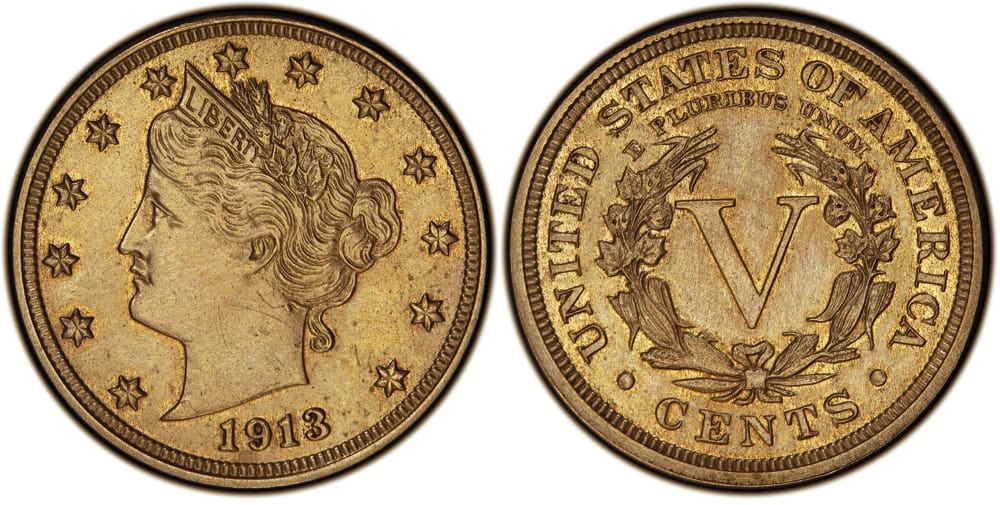
The 7th place in the top of the most expensive coins in the world is supplemented by the "Liberty Head". Initially, its price was only 5 cents. In 1913, it was minted without the knowledge of the American Mint. The last time its price was 3,700 thousand dollars. However, if a copy of the "Liberty Head" in excellent condition is found for sale, then the cost, according to expert estimates, will reach more than 3,000,000 dollars.
Queller Silver Dollar - $3.7 million
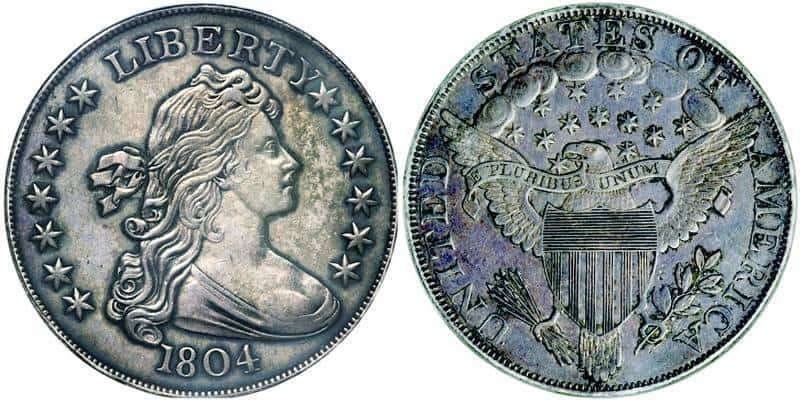
The Queller silver dollar, which is included in the list of the most expensive coins in the world, began to be used as a monetary unit in the United States of America in 1834. This specimen is considered unique due to the fact that the year of issue does not correspond to the one that was stamped on the coin - 1804. This is due to the fact that in that year the last coins with a denomination of 1 dollar were issued, in the production of which silver was used.
Eight gift sets of silver dollars were minted and issued specifically for the Asian trading partners. The portrait of Anna Bingham was used as a prototype for the image on the front side. The last Queller dollar was purchased for $3,737,500.
Elizabeth II coin - $4 million

In 2007, the Canadian Mint developed the most unusual design of a gold coin, on the front side of which is a portrait of Queen Elizabeth II, and on the back - a maple leaf. The weight of this coin is 100 kilograms, and its diameter is 53 centimeters. In the manufacturing process, gold of the highest standard was used. The nominal value of the coin is 1,000,000 dollars. Before it was sold at auction for 4,000,000 dollars, the coin was in a museum.
Little Silver Dollar - $4 million

The next most expensive coin in the list is the Little Silver Dollar, minted from silver in the first half of the 19th century. The coin was specially minted for the great and passionate numismatist, the King of Siam. The last time the antique specimen was sold was to an unknown private collector for over $4 million.
Florin from the time of Edward III - $6.8 million

The florin was used in the Middle Ages in England. The country was ruled by Edward III at that time. On the front side of the coin, it is possible to see the figure of the king sitting on the throne and certain elements of the palace, which can be seen in the photo on the Internet. The edges of the coin do not have clear boundaries, which clearly indicates the absence of a rim. At the time of the production of metal florins, minting technology was just emerging.
This coin was the first to be made of gold and was intended for permanent use. Its weight is 9.96 g, while gold does not have any impurities from other metals, and the florin cost 6 shillings. The third in the list of the most expensive coins in the world costs 6,800,000 dollars.
Saint-Gaudens Double Eagle - $7.59 million
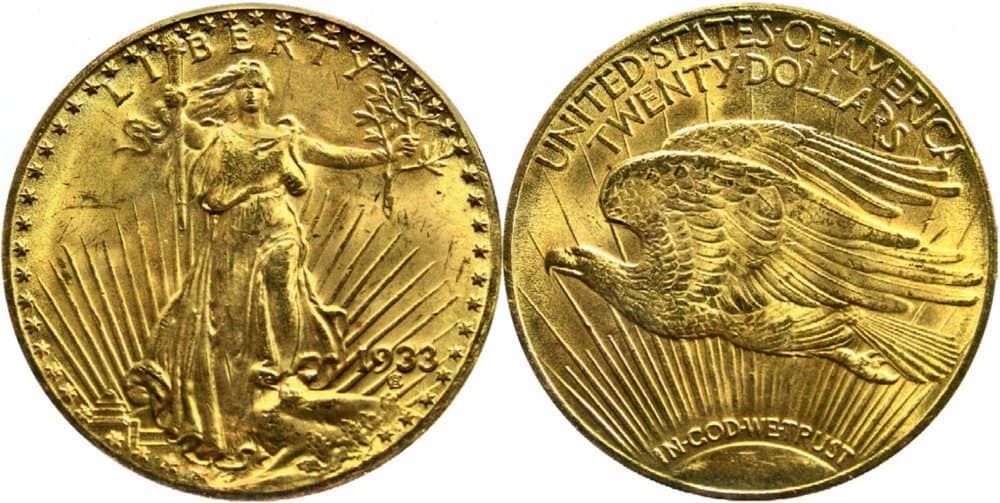
The Saint-Gaudens Double Eagle is rightfully considered one of the most valuable and rarest coins. It was developed and minted in 1907, and the coin was made of pure gold. It was last issued in 1933. This currency was developed to stabilize the economic situation in the United States of America.
After gold coins were abolished and withdrawn from circulation, they began to be bought up at a price that was several times higher than their face value, in order to melt them down into ingots. Several pieces were hidden and later sold to a jeweler by mint workers. However, as a result of the intervention of the secret services, the loss was discovered and returned. One Saint-Gaudens Double Eagle is owned by a private collector. To become its owner, it was necessary to pay 7,590,020 US dollars.
Dollar Loose Hair - $7.85 million
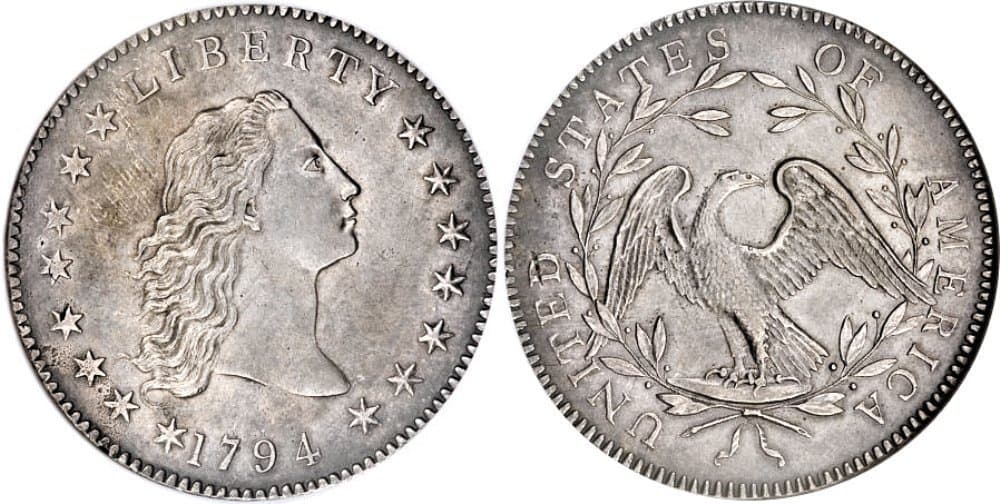
The rarest and most expensive coin in the world is the Loose Hair dollar. This monetary unit was the first representative of a series of coins that began to be minted from high-grade silver in the United States of America, and was used from 1794 to 1804.
It was in circulation for two years. There were 2 thousand coins in circulation, most of them were sent to be melted down, as they had a low quality of casting. Two hundred silver coins have survived to this day. The main aspect by which one can recognize this sample of ancient monetary units is considered to be the depicted profile of a woman with loose hair. They say that in this way the creators of this coin wanted to convey the symbolic image of American freedom. The question of how much the most expensive coin in the world costs can be answered as follows: the last time the dollar "Loose Hair" was sold at auction was for 7,850,000 dollars.
10 Most Expensive Coins of Russia
A valuable coin is a real find, but sometimes the owners don’t even suspect its real value. Expensive coins can be stored right in your wallet, but you may not even guess about it. It turns out that ordinary metal banknotes, which we use every day in the circulation of money, can sometimes cost much more - several thousand rubles. And if you are lucky enough to find a coin that seems valuable to you, then go to a numismatist (a collector and connoisseur of coins and medals). He will be the one to indicate its real value.
An auxiliary historical discipline that studies the history of coinage is numismatics. Coin prices may vary, so you should not sell valuables on the black market, as their value is significantly underestimated there. In addition, the buyer may try to convince you that you have a fake. You cannot immediately believe this, as he simply wants to reduce the value of the item. It is important to understand that the real price may differ significantly from the one indicated directly on the coin. It may vary depending on the origin and condition of the money.
How is the cost determined?
Why are some coins so expensive? The thing is that over the past fifteen years, many metal banknotes of different denominations have been issued. At that time, the mints did not even guess that some of them would be so rare that their price would increase many times over. The main reason for this is the release of a limited edition of coins that penetrated the general money supply. And now anyone who has one of them will be able to sell it for much more. The cost of Russian coins (1997-2014) is not considered too high now. However, after some time, it should increase. Of course, old metal money is considered more valuable, so you can sell them for more. But this already depends on the condition and appearance. The main thing is not to try to renew the coin yourself, since this may underestimate its cost. Numismatics warns about all this. Prices for coins can vary. As a rule, the final cost is determined after a numismatist examines a specific specimen.
Modern expensive coins
Expensive coins of modern Russia are those that were issued in small quantities, but entered into circulation. Jubilee money also belongs to them. One of such coins can be called the one produced in 2001, with a face value of 50 kopecks. According to various numismatists, its price fluctuates in the range of 30,000-100,000 rubles. Such specimens were minted at the Moscow Mint (MMD). It is still unknown in what quantity and why they entered circulation. At present, only a few kopecks of 2001 with this face value have been found. The main feature of this banknote is the letter "M" located under the horse's hoof.
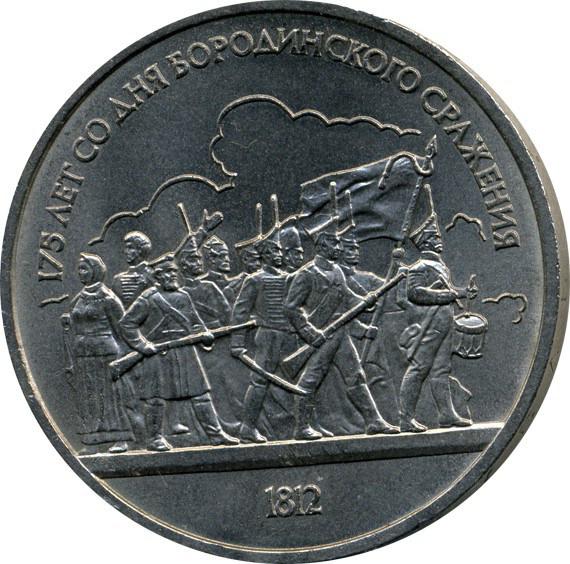
The Moscow Mint also minted other coins in 2001, which for unknown reasons entered into circulation. These include the two-ruble and one-ruble coins of 2001. Currently, their value fluctuates around 30,000 rubles. The ruble coin is distinguished by the presence of the abbreviation MMD under the horse's hoof. However, the money called "Ten Years of the CIS" is not considered valuable, since it is a jubilee coin. The fact is that all jubilee coins produced in 2001 and 2003 are valued at their real value. Commemorative metal banknotes that are currently issued are also valued at their real price. After all, they are issued in fairly large print runs.
In 2003, ruble, two-ruble and five-ruble coins were minted, which can be sold for much more - from 10 thousand rubles and up. The same applies to defective ones, which do not have a mint mark (only those that were issued in 2002 and 2003). The "Gagarin" coins can also be called expensive, which numismatists estimate at about 4-5 thousand.
Commemorative Russian coins
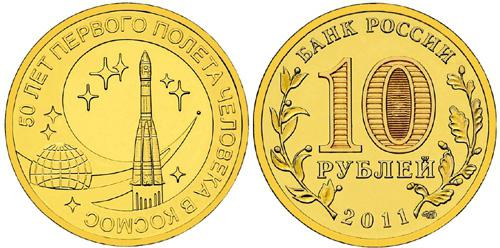
In addition to the usual ones, there are also jubilee coins minted from inexpensive metals. They are produced as a memory of some event, and can also be issued in large series over several years in a row. Thus, the jubilee coins of 2001 and 2003 are not valuable, since they were produced in large quantities during this period.
Metal banknotes with a face value of 10 rubles have also become widespread, which is why they are valued at their real price. But if the coins have been well preserved, they can be sold a little higher than their face value. The price is determined depending on the circulation and appearance. The list of "Expensive coins of modern Russia" also includes some jubilee coins, but not all. Usually, their cost does not exceed 1000-3000 rubles.
Rare are those specimens that were minted in limited editions. Some of them are even issued without documentary confirmation from mints. In some cases, there is not enough information about such valuable coins. And all that is known about them is just a few photographs or records. So, at the moment, the most valuable specimen in Russia is a 1999 coin with a face value of 5 rubles. It must have the stamp of the Moscow Mint (MMD). Experts are ready to pay at least 250,000 rubles for it. This is the most expensive coin in Russia. So far, only a few similar specimens have been discovered.
The most expensive coins in the Russian Federation
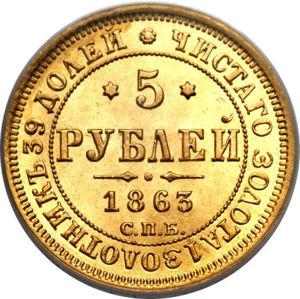
It has already been said that the most expensive coin in Russia is the 1999 specimen with a denomination of 5 rubles.
But besides it, you can also find others that cost less, but are still considered valuable. Let's look at several coins that can be sold at a high price:
- 50 kopecks, minted in 2001. This currency was issued by the Moscow Mint, although there is no official confirmation that it has entered circulation. However, it is in circulation. The person who finds it can become richer by 120,000 rubles.
- 1 ruble, issued in 2001. The coin was also minted by the Moscow Mint, but was not officially put into circulation. Experts estimate its value at approximately 30,000 rubles, depending on its condition. Collectors are willing to pay the same amount for a two-ruble coin from the same year.
- 1 ruble 2003. It was issued by SPMD (St. Petersburg Mint). Its cost starts from 15,000 rubles.
If you think you have made a valuable find, it is better to contact a numismatist who will determine its real value. After all, expensive metal banknotes are practically no different from those that enter circulation every day. The most expensive coin in Russia can end up in the home of any Russian, bringing him a big profit.
How much are Russian coins worth since 1995
The table of the value of Russian coins can help you navigate this area quickly and easily. Print it on your printer. The list of coins will always be at hand. It will be very convenient to check the money in your wallet. And suddenly you will be lucky and it will be you who will have the most expensive coin in Russia.
| Item No. | Denomination | Year | Price |
| 1 | 1 ruble | 2001 | 15,000 rubles |
| 2 | 2 rubles | 2003 | 10,000 rubles |
| 3 | 5 rubles | 2003 | Unknown |
| 4 | 50 kopecks | 2001 | Unknown |
| 5 | 5 kopecks | 2001 | 5000 rubles |
| 6 | 5 kopecks | 1999 | 15,000 rubles |
| 7 | 5 rubles | 2003 | Unknown |
| 8 | 1 ruble | 1999 | Unknown |
| 9 | 50 kopecks | 2003 | Unknown |
| 10 | 2 rubles | 2001 | 2000 rubles |
The price unknown mark means that the coins in question are so rare that there is no precise indication of their value.
This table of the value of Russian coins is incomplete, as it is constantly updated. And in general, not only modern metal banknotes can be considered rare, but also those that existed several centuries ago.

Expensive copper coins
The numismatic market is currently flourishing. This is especially due to the fall of the ruble, thanks to which you can make good money buying and selling old money. Many people believe that copper coins are not too expensive because they are made of inexpensive materials. However, this is not entirely true. The production of copper coins was established back in the days of Peter the Great. Therefore, such money has great historical significance. Let's look at some of the most expensive coins made of copper:
1 kopeck 1704
Numismatists estimate it at 5 million rubles. The peculiarity of such a coin is its interesting history. It owes its appearance to the monetary reform of Peter I. Copper coins with a small denomination were introduced in 1700. The purpose of their creation was to eliminate the problems that arose in the process of exchanging silver kopecks. If a kopeck with a larger denomination had been created, then problems with duplicating denominations could have arisen. But no one needed them.
1 kopeck, issued in 1724
It is also called a frame coin. The cost of the coins of Tsarist Russia is, of course, much higher, so collectors are ready to pay about 13,000 dollars for such a specimen. It was minted at the mint in Kadashev (Nizhny Novgorod). The high cost is due to the fact that it is extremely rare to find it. Only a few specimens have been discovered so far.
Copper grivna of 1726 - 1 million rubles
Numismatists buy such specimens for no less than 1,000,000 rubles. This is a coin-plate issued at the Yekaterinburg platovy yard. Such money is very rare at Russian auctions.
1 kopeck of 1755 - 3.8 million rubles
The coin was made of copper at the mint in the city of St. Petersburg.
Commemorative coins of the tsarist era
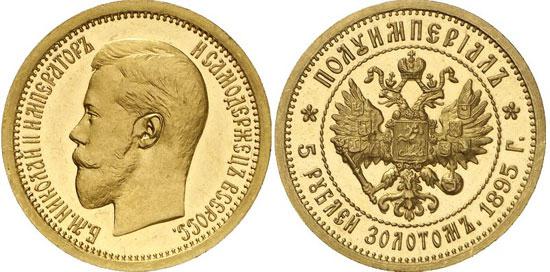
The history of commemorative coins is very fascinating. Almost all numismatists know it, because it helps them determine the authenticity of a particular monetary unit. The cost of coins of tsarist Russia is primarily due to the fact that they are ancient. In addition, almost all tsarist coins were made of precious metals, so their price increases due to this. The first commemorative copy was issued in 1832. This happened in Altai in honor of the opening of the Kolyvano-Voznesensk mines. Gold mined in these mines was used for minting coins. 1834 was marked by the appearance of the first silver ruble, the issue of which was dedicated to Alexander I. In 1839, a commemorative coin of one and a half rubles was also issued in honor of the Battle of Borodino. All commemorative rubles, coins of Russia are in great demand among numismatists, but they are extremely rare. The fact is that they were released in a small edition, so their owners become the owners of a real treasure.
Platinum coins
Platinum is a noble metal that was almost never used for minting coins. This was mainly not because platinum is a very expensive metal and no one wanted to use it for this purpose. On the contrary, there were many attempts to mint coins from this material. However, platinum begins to melt at very high temperatures, so during the times of Tsarist Russia, people could not freely make items from it. Nevertheless, a small print run of such coins was issued then, which, although rare, are found in the collections of numismatists. Naturally, their value is very high. Sometimes it reaches several million rubles.
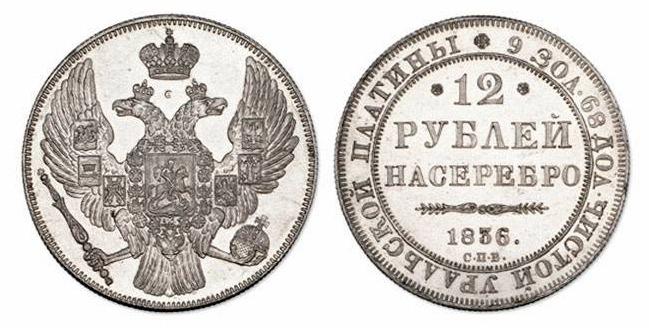
They learned to mint platinum coins only in the nineteenth century, namely in 1835. The coat of arms of the Russian Empire was depicted on the back, and the inscription "For silver" was on the front. You could only find three types of platinum coins: 3, 6 and 12 rubles. The shape of the items resembled silver coins, but platinum was 6 times more expensive. Therefore, you could buy much more goods for such a monetary unit. For example, a coin with a denomination of 6 rubles was 6 times more expensive than the same silver one. This is exactly what the inscription "For silver" said. Pure platinum mined in the Urals was used in the process of making coins. Since 1846, platinum has ceased to be used for minting, since a huge number of counterfeits began to appear. Silver coins were easily confused with platinum ones, so merchants began to be indignant. All metal banknotes were withdrawn from circulation, and only a few copies have survived to this day. That is why their cost is so high. Although you will definitely not be able to find such a thing in your wallet: for this you need to organize entire archaeological excavations.
Where can I sell rare coins?
Although the chances of becoming the owner of a valuable coin are small, they still exist. And if you suddenly find such a specimen in your wallet that can be sold at a high price, do not rush to clean it and put it in order. After all, unprofessional cleaning can cause the price of the coin to drop sharply, and you will no longer be able to sell it for full value. This can happen due to scratches on the surface of the find or some other defects.
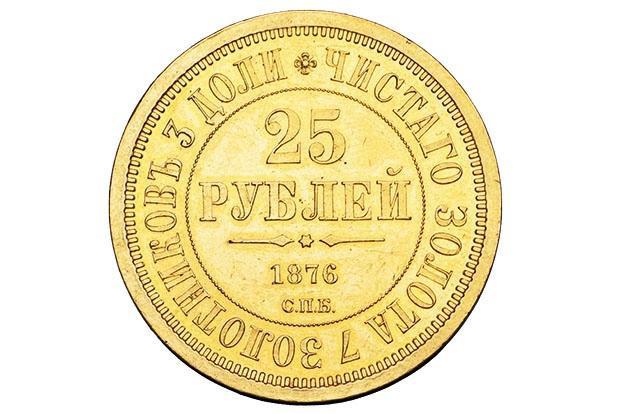
Wanting to find out how much a coin you've found is worth, you don't necessarily have to go looking for numismatists. It's enough to print a corresponding ad in a newspaper along with a photo of the sample. If the find turns out to be really worthwhile, you'll definitely be contacted. You should never set your own price. If it's too high, no one will buy the coin. At the same time, if the price is too low, you'll definitely not be a winner.
If a specimen dating back to the Russian Empire era was found, it can also be sold. In this case, it will fetch a good price. In addition, the person who purchased the royal specimen also receives a certain benefit. After all, his collection of royal coins will be increased by another expensive and rare addition. It is best to use the services of online auctions. To do this, you need to put your item up for sale and wait until someone offers a suitable price. There is also a catalog with photos where you can see the description and cost of similar items. This will help to roughly determine how much you can get for selling an ancient coin.
The most expensive coins of Ukraine can be in your piggy bank
Tell me, do you get very upset when change is given in small change at the store? And, most likely, you demonstratively leave it? In vain. Look closely at the coins, because among them there may be a specimen that costs three or more thousand hryvnias.
After the collapse of the USSR, coins in Ukraine began to be minted at the Lugansk Machine-Building Plant. At first, the Ukrainian "kopiyka" was planned to be called "shagi". There were trial runs, the design was developed, the coins were improved, after which the first coins entered circulation.
Some of them were defective, because the workers worked irresponsibly (even though they made money, they did not receive wages, like the rest of the country); sometimes they mixed up the blanks (10 kopecks on white metal, 1 kopeck on yellow), or the printing press produced defects. It happened that the obverse of the coin was turned 180 degrees (i.e. one side of the coin was upside down in relation to the other).
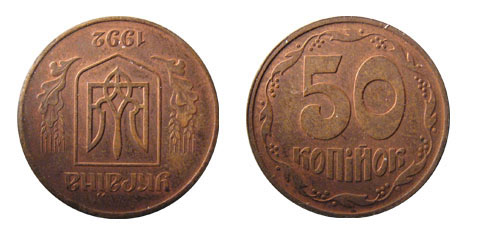
50 kopecks. Obverse rotated 180 degrees.
There were also coins with two coats of arms and two denominations, i.e. either with two obverses or with two reverses.

50 kopecks. Two reverses.
These are the coins that are of great value to numismatists. So if you have these kopecks, you can sell them profitably.
The small change from trial editions is in great demand, it was issued in limited quantities, put into circulation and is still in circulation, while the cost of one kopeck is many times higher than its face value. So, grab a hammer and let's go and start ripping up the piggy bank. You need to look for the following:
— 1 kopeck 1994, trial edition, cost from 100 to 250 UAH.
— 2 kopecks 1992, they say there are only about 100 of them, minted at the Lugansk Machine Tool Plant, on the Internet they ask 200-500 UAH for them, but the real cost is 3100 UAH.

2 kopecks, 1992
— Rare coin — 5 kopecks 1994, the price is from 2500 to 4000 hryvnia, although cunning numismatists ask for only 100-200 hryvnia for it.
— They were minted in a trial run. 25 kopecks in 1995, only about 20 thousand copies, they can be sold for 100-250 hryvnia.
— 1 hryvnia 1992, a rare coin. Put into circulation on March 12, 1997, mintage 150 pieces, cost on the Internet 500-650 UAH, in reality you can ask for 2000-5000 UAH.
Don't be surprised, but initially there was also a coin with a face value of 15 kopecks, it did not enter circulation, but a trial batch was minted. Numismatists claim that by some chance the "fifteen" was found in circulation and now the whole country is looking for this coin. Collectors offer to buy it from 1500 UAH.
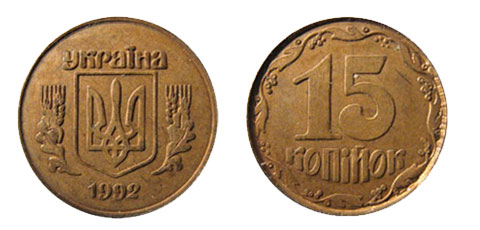
15 kopecks, 1992
Coins issued in limited editions especially for collectors are also valuable. Usually these are coins of high quality and they are found in private collections, but they can also be found in circulation, the cost of collectible coins is from 30 to 100 hryvnia.
1 kopeck 1994. 1700-3000 UAH

It is found less often than one in 30,000. It was minted in 1994 at the Lugansk plant. It has a high price due to the small circulation. The coin is not magnetic and can be made of: silver, non-magnetic steel, nickel-plated copper, etc. The price depends on the condition of the coin and the metal it is made of. The most expensive 1 kopeck of 1994 was sold for 7430 UAH in 2016.
1 kopeck 1996. 250-1500 UAH
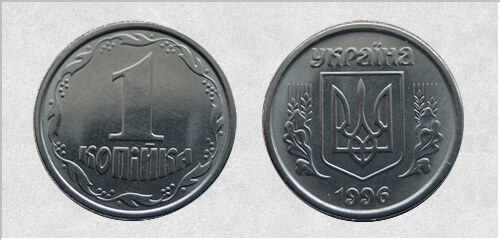
The coin has a higher quality, letters in thick font. Can be made of: non-magnetic steel, aluminum, light brass, silver, magnetic steel with brass or copper coating. The price directly depends on the condition of the coin and the metal it is made of.
2 kopecks 1992. 10,000-19,000 UAH
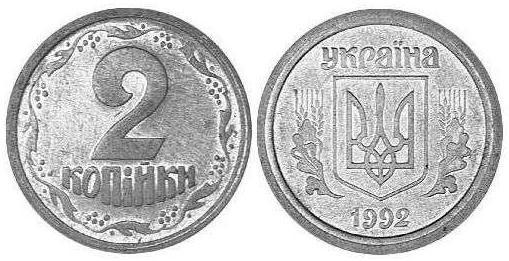
A trial coin, has a narrow wreath on the obverse, distant from the edge. The minting was done with matrices obtained from England. The highest value is for coins made of non-magnetic steel and nickel alloy. 2 kopecks 1992.
2 kopecks 1996. 350-1500 UAH

It is mainly found in collector sets, has a higher quality. It has a wide wreath and a wide font size. The mintage of the coin is 7,000 copies. The highest value is for coins made of brass and copper. 2 kopecks of 1996
5 kopecks 1994. 2000−7500 UAH

A very rare coin, there is information that only 300 copies were issued. The inscription "kopiyok" has a thick font. The highest value is for coins made of silver, brass and copper. 5 kopecks of 1994
5 kopecks 1996. 500-3000 UAH
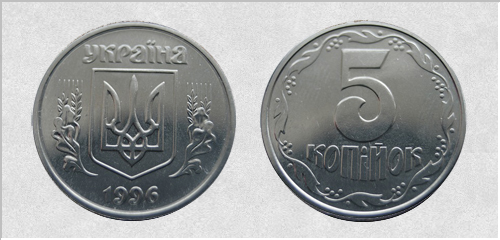
The coin was minted exclusively from stainless steel. Only 5,000 pieces were issued. 5 kopecks 1996
5 kopecks 2001. 400-700 UAH
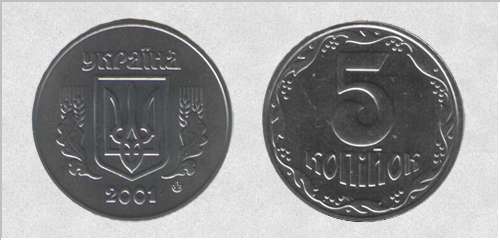
The coin was minted from magnetic steel in the mint of the National Bank of Ukraine. Compared to coins of the same denomination, it has a smaller size of the image. Only 5,000 copies were issued, only for souvenir sets. 5 kopecks of 2001
10 kopecks 2001. 300-700 UAH
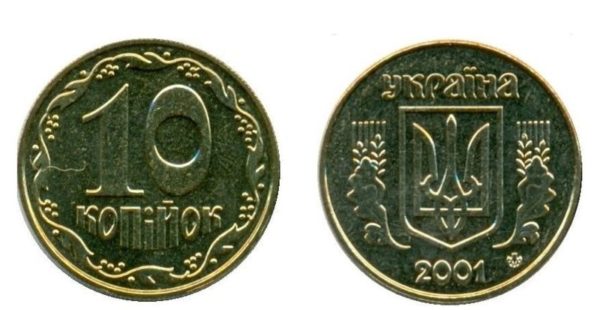
The coin was minted from an alloy of aluminum and bronze. Only 5,000 copies were issued.
25 kopecks 1995. 500-2500 UAH
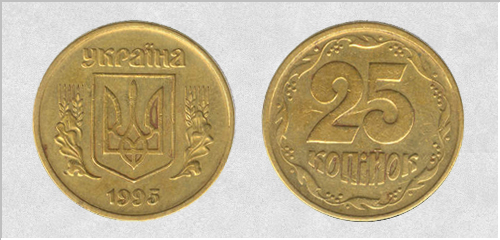
A trial coin from the Luhansk plant, 20,000 pieces were issued. It was minted from magnetic and non-magnetic steel, copper and brass. Coins with small notches on the edge are sold for 500-1000 UAH. Coins with large notches cost 1500-2500 UAH. 25 kopecks of 1995
25 kopecks 2001. 500 UAH
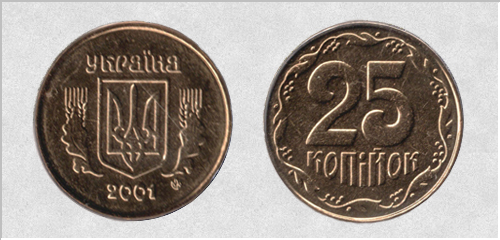
Only 25 kopecks of 2001, which have a higher quality, are valuable. The coin was produced at the NBU mint from an alloy of bronze and aluminum in a limited edition of 5 thousand copies. The most expensive 25 kopecks of 2001 were sold for 856 UAH in 2015. 25 kopecks of 2001
25 kopecks 2003. 1000-2500 UAH
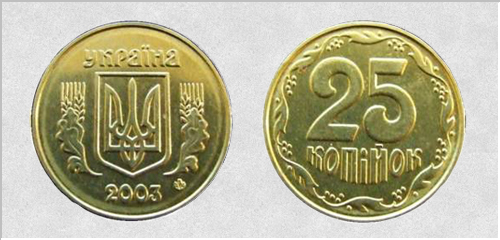
The coin was produced at the NBU Mint from an alloy of bronze and aluminum in a limited edition of 5 thousand copies exclusively for souvenir numismatic collections. 25 kopecks 2003
50 kopecks 2001. 350 UAH

The coin was minted in high quality from an alloy of aluminum and bronze in a circulation of 5,000 copies especially for souvenir numismatic sets. 50 kopecks of 2001
50 kopecks 2003. 1500 UAH
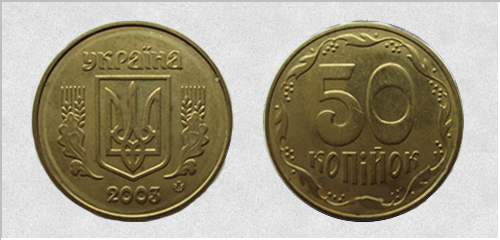
It has a clearer design than coins of the same denomination of other years. The coin was minted from an alloy of aluminum and bronze in a circulation of 5,000 copies. 50 kopecks 2003
1 hryvnia 2008. from 200 UAH

The coin was made at the NBU mint from an alloy of aluminum and bronze. It has a clearer and shinier design than coins of other years. The reverse depicts Prince Vladimir.
Tips for buying and selling coins
It is better to sell coins at specialized auctions, and not to resellers who significantly lower the price. Before buying a coin, you need to familiarize yourself well with the history of its minting, and be careful when checking the authenticity of the specimen. If you are not sure of the authenticity of the coin, refuse to buy. It is better to pay money to professionals than to be deceived.
Well, have you checked the whole piggy bank yet? Did you find anything? No? Then let's start all over again, you will need a magnet. 10, 25, 50 kopecks and a hryvnia in yellow metal, which are attracted by a magnet, can also be sold profitably. Moreover, the stronger the coin is magnetized, the higher its value.
Now the expression “a penny saved is a penny earned” becomes logical, especially if this penny is the rarest coin in Ukraine, and therefore the most expensive.
Most likely, you will no longer swear at the store because you were filled with pocketfuls of change; your task is to quickly count the change and then check if there is a coin in there that most numismatists are hunting for.
An interesting fact is that the main coins were ordered in Italy until 1993, since at that time Ukraine simply did not have the capacity or means for minting. A little later, coin production was organized in Lugansk, where, along with ordinary coins, trial coins were also made (for example, a rare one with a denomination of 15 kopecks and others).
It is precisely these experimental samples that are the most valuable, interesting and rare, and which are highly sought after by both amateurs and professional collectors.





